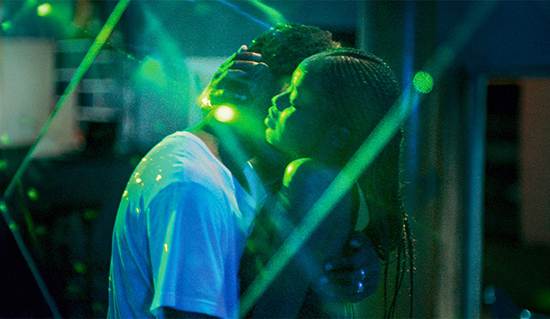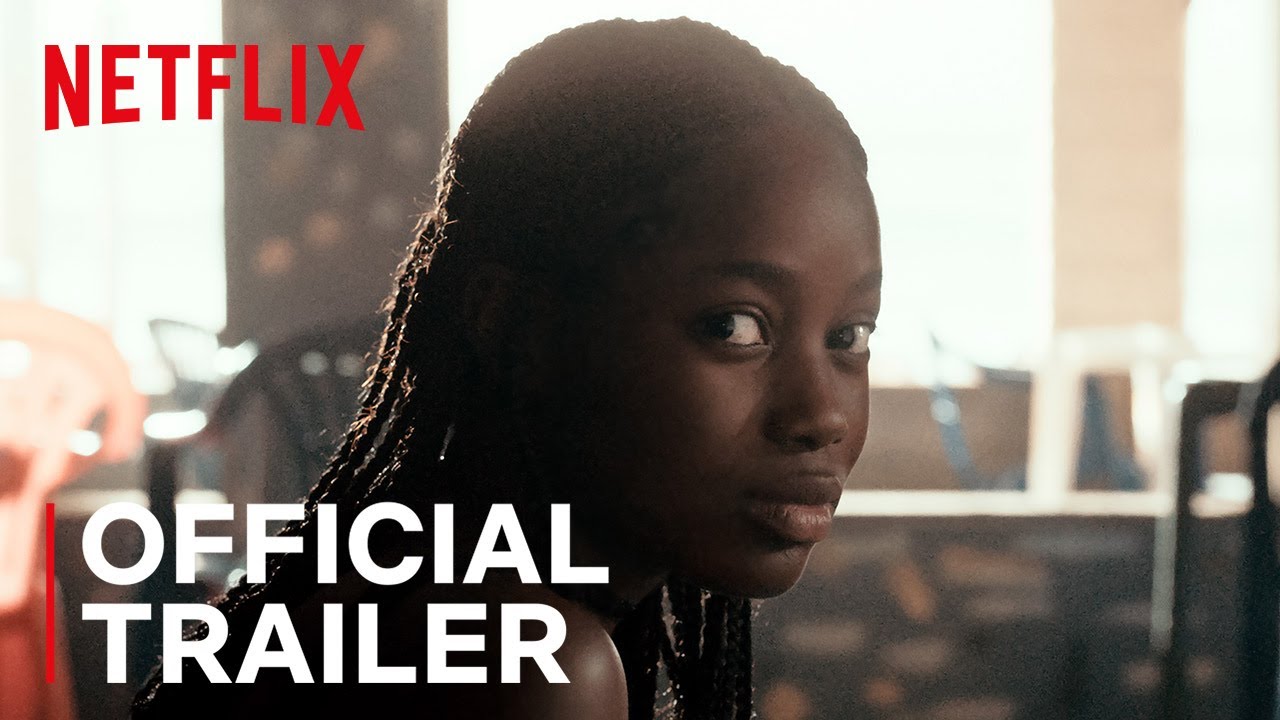As a child I was told—and warned—of djinns. Never having encountered one, I relished the stories of my cousins, nearly begging to hear again of the possessed woman who began to pray backwards; her back, now supple, turning away from the mat with her head facing upwards instead of kneeling down to the ground. Or the story of the whispered, reverse-recited prayers from the Quran that wished djinns onto certain beings. I would quiver from the high of the mystery. What were djinns? Each story abstracted them (although you could say they are ontologically abstract) to the point where I could never wholly explain or understand, just knowing that they stained the air with a palpable eeriness. Even the stories of djinns could haunt in place of the djinns themselves, but in the most sublime of ways.
The whited-out eyes of the women possessed by djinns in French Senegalese director Mati Diop’s Atlantics paint a very different picture of my childhood fears and thrills. Discontinuing the thematic link of reversal that I had deemed the marker of a djinn, the djinn in Atlantics instead marks a very physical return of the dead who have come for a purpose. The ghosts, spirits, dead, or djinns in their previous lives were construction workers in Dakar, Senegal for a Futurist building (think of a mix between Zaha Hadid’s neo-futurist buildings with the modern-ethos of Monument to the Third International, and Cui Jie’s dystopian paintings of China’s rapid urbanization) and have come back to demand their back-pay—the cause of which they died, sailing overseas to Spain in search of paid labor to send money back to their families.
Of the djinns includes the protagonist Ada’s lover, Souleiman, who comes back at night, in the form of the police detective interrogating her, to see her. Souleiman, or his djinn, immediately causes chaos, setting on fire Ada’s nuptial bed on the night of her wedding to the wealthy Omar. It is this return that completely overtakes the plot of the film from the protagonist, signifying the ending of the film, where after making love to Souleiman as the cop, Ada proclaims “I am Ada” to herself in the mirror, offering an ending more of a deus ex machina than some sort of resolve. Between her beloved Souleiman, her fiancé Omar, the unrelenting detective, and the rest of Souleiman’s dead coworkers, we lose Ada. To see her staring at herself in the mirror proclaiming her being, while empowering, does not coordinate with her narrative arc or contextual plot throughout the film. I found myself again enthralled by the djinns, and nearly forgot about Ada’s story.
Winner of the Grand Prix at this year’s Cannes Film Festival, Atlantics is, undoubtedly, a favorite film of the year for many, including myself. The coming-of-age/magical realist/horror film successfully deals with critical contemporary issues of class disparity, migration, past and present traumas and futurist thinkings seamlessly, through a tragic love story to root for—and, of course, the djinns. Less than a critique, my questioning of the film’s plot better situates it as a moving image; a thing in itself rather than a linear, narrative film or a film about something, particularly when considering Fatima Al Qadiri’s haunting score and Claire Mathon’s stunning cinematography.
Situating Atlantics within a context of the associations carried with an image or sound, the question of the plot becomes secondary. Instead, through a Deleuzian concept of the ruins of the image as the bringing of something new, we can mobilize this ambiguity (a ruin of the image of sorts) as precisely what the story centers. This centering opens up the speculative nature of the ambiguity, and we can better appreciate the abstract visual and sonic elements. Al Qadiri’s soundtrack is far from linear, emoting sonically the amalgamation of the past haunting the present as well as the presence of the future, via the looming building in the film. The score achieves this by slowing down the pace, and deepening voices in certain tracks such “Suñu Khalis”— stretching time overlaying the past in the present in real time.
Its range, of minimal to complex electronic beats and various distortions, works to create a futuristic sound that is ethereal, invoking haunted and compelling sonics and, thus, the past. Throughout the entirety of the sublime, melancholic score there is a feeling of anticipation in the building up of beats. There is then a monotonous repetition and a subsequent unexpected interruption, particularly in “Qasida – Sunset Fever 1” and “Qasida – Sunset Fever 2”, the latter of which offers a more reverberatory version of the first. The film depends on the score for certain associations, as when we hear the ocean waves both beginning and ending “Ada and Souleiman”—the source of freedom and possibility for the two and, simultaneously, the very material demise. The ocean waves on this track not only indicate the metaphorical significance of the water to the film and the lovers’ relationship, but also the cyclical nature of the latter. While it marks the ending for the two, it can also be heard as the beginning, as the end, does not seem near, given that Souleiman has indeed come back – in spirit.
In queer theorist Ronak Kapadia’s Sonic Contagions: Bird Flu, Bandun, and the Queer Cartographies of MIA he argues for music, specifically MIA’s “Bird Flu”, as an “affective transmission” that creates a queer mapping or contagionwhich results in points of contact between different communities around the Global South and its diasporas. This leads to alternative knowledges, belonging, and imaginations (or possibilities). Kapadia describes (MIA’s) music as a cultural archive with points of connecting with sampling, creating alternate futures or possibilities. Extending this to Al Qadiri’s practice is not surprising, especially with works such as her BBC4 episode of “The Sound of Bombs” on the sounds of warfare that both explores this work and speculates on the music’s potential to challenge and imagine other possibilities of warfare by engaging with such sounds, such as the idea of walls or waves of sound. Given that Diop’s 2009 short experimental film, Atlantiques was based on the stories of young African men taking the extremely dangerous trip to Europe, we can see how the two artists’ works draw from contemporary political and social situations informed by the repercussions of neo-colonial and historico-political contexts.
In the BBC4 episode, Al Qadiri describes her time in Kuwait during the first Gulf War as “the most sci-fi, haunting experience” of her life—a sonic tone and theme we can see carried throughout her practice including the Atlantics score with its chilling effects, even in moments where it seems to belong to a horror story. This includes the sound in the procession for Ada’s wedding in “Yelwa Procession”, combining celebratory chanting with a slowed, warped sound oozing into a cacophonous, eerie track. Such distortions create the points of contact that Kapadia mentions, although in terms of temporal connections. The ambiguity of the tracks plays into not only the suspense of the film, but the potential of radical imaginings of the future that come with such mystery. Kapadia’s “affective transmission” is something best understood when listening to the score viscerally —something I feel again and again with “Body Double”, one of the most stimulating and more melodic tracks.
Al Qadiri’s entrancing work offers up the foundation on which the viewer sees stimulating visuals: The fantastical floating head sculpture at the luxury pool Omar swims in—a very different body of water than the ocean, which is a source of precariousness and freedom; the recurring visuals of the club green lights at Dior’s; the djinns; or, most importantly, the obnoxiously large modern tower that caused the boys to set out for Spain and their ultimate deaths to the ocean.
In the prologue to Letters to the Future: Black WOMEN/Radical WRITING, an anthology of late-modern and contemporary poems, essays, conversations, and visual works of the speculative, innovative and futurist nature by Black women, the editors write, “Necessarily, the relation to the body that speaks is a future space of anticipation, a movement away from the embodied subject, untroubled, and toward a being of the multiple, as if to indicate that selfhood itself, especially for some of us, takes the shape of a conversation imagined in the moment immediately following the present.” The editors describe a relation to the body, selfhood and speculative futures toward “a being of the multiple” in conversation—something that Diop implements at the level of the djinns where embodiment, rather than a distanced affective form, takes on a very physical but also spectral form. This spiritual and/or phantom happening only occurs via engagement and with a parallel appeal for imaginings and futurisms implemented on the aesthetic level.
Through Hunt, Martin and the various writers in Letters to the Future, we see that the multiples, or communities (resonating with Kapadia’s ideas) contribute most so to the idea of autonomy, and the imaginings and seemingly impossible futures of autonomous identities, free of the atemporal binds of imperialism, capitalism, and neo-colonialism. This emphasis on the multiple is why I am not as troubled by the lack of strengthening Ada’s selfhood, or autonomy, in the plot. Listening to Al Qadiri’s hypnotic amalgamation of sounds while walking around in Paris at night, I was caught off guard by the green light of the flashing crosses that illuminate most pharmacies here. I was, momentarily, doused in it – as Ada is by the rotating lights at Dior’s. It happened right at the moment one of her tracks sounded as if it were to hit a climax, instead reaching a lulling, entrancing point. The feeling was not unlike the moment Ada learns of and believes in the djinns, and absolutely not unlike the djinn stories I begged to hear of as a child.
Atlantics is in cinemas and on Netflix now



